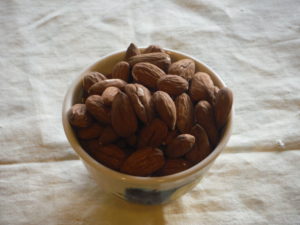I have written numerous times about the risk posed to urban and rural forests posed by the polyphagous and Kuroshio shot hole borers and their associated fungi. (Blog exploring risk to urban forests; discussion of need for regulation.)
Yet neither California authorities nor USDA APHIS has put significant effort into containing these insects – which continue to spread north in the state. Perhaps this will change in response to the U.S. Senate’s Agriculture appropriations report, which on p. 39 instructs the Secretary of Agriculture to report on steps being taken to “to minimize the spread of other pests such as the polyphagous and Kuroshio shot hole borers.”
Another possible spur to action is that scientists have now proved that the Fusarium euwallaceae fungus – the primary fungus transported by these beetles – can infect almond trees — a major economic crop in the San Joaquin Valley of California. The polyphagous shot hole borer is known to be in Santa Barbara and San Luis Obispo counties – ever closer to the agricultural areas. California produces 82% of total global production of almonds. In 2015, the state’s almond production was valued at $5.33 billion. $5.14 billion (96%) of this production was exported (California Agricultural Production Statistics).
Already, the polyphagous shot hole borer threatens a wide range of native and horticultural trees in the region. (Damage to avocado trees is less than originally believed.) Together, the polyphagous and Kuroshio shot hole borers and their associated fungi threaten more than a third of trees in the urban forests in southern California, with a cost for the trees’ removal and replacement estimated at $36 billion.
Hosts native in southern California:
- Box elder (Acer negundo)
- Big leaf maple (Acer macrophyllum)
- California Sycamore (Platanus racemosa)
- Red Willow (Salix laevigata)
- Arroyo willow (Salix lasiolepsis)
- Goodding’s black willow (Salix gooddingii)
- Coast live oak (Quercus agrifolia)
- Engelmann Oak (Quercus engelmannii)
- Valley oak (Quercus lobata)
- Canyon live oak (Quercus chrysolepis)
- Fremont Cottonwood (Populus fremontii)
- Black cottonwood (Populus trichocarpa) *
- White alder (Alnus rhombifolia)
- Blue palo verde (Cercidium floridum)
- Palo verde (Parkinsonia aculeata)
- Mesquite (Prosopis articulata)
- Mule Fat (Baccharis salicifolia)
- California buckeye (Aesculus californica)
Hosts that are exotics but widespread in southern California:
- Avocado (Persea americana)
- Castor bean (Ricinus communis)
- English Oak (Quercus robur)
- London plane (Platanus x acerifolia)
- Coral tree (Erythrina corallodendon)*
- Brea (Cercidium sonorae)
- Weeping willow (Salix babylonica)
- Red Flowering Gum (Eucalyptus ficifolia)
- Tree of heaven (Ailanthus altissima)
- Kurrajong (Brachychiton populneus)
- Black mission fig (Ficus carica)
- Japanese beech (Fagus crenata)
- Dense logwood/Shiny xylosma (Xylosma congestum)
- Black Poplar (Populus nigra)
- Carrotwood (Cupaniopsis anacardioides)
- Kentia Palm (Howea forsteriana)
- King Palm (Archontophoenix cunninghamiana)
- Tamarix (Tamarix ramosissima)
Hosts that are native or widespread exotics in the Southeastern states:
- Box elder (Acer negundo) (repeated from above)
- Liquidambar (Liquidambar styraciflua)
- Japanese wisteria (Wisteria floribunda)
- Tree of heaven (Alianthus altissima)
Hosts that are sold interstate in the nursery trade (note that PSHB, at least, has attacked branches as small as 2.5 cm – Coleman, 2016):
- Japanese maple (Acer palmatum)
- Camelia (Camellia semiserrata)
- Chinese holly (Ilex cornuta)
See also the writeup at www.dontmovefirewood.org
Source:
Moreno, K., J.D. Carrillo, F. Trouillas, A. Eskalen. 9/24/2017 Almond (Prunus dulcis) is susceptible to Fusarium euwallaceae, a fungal pathogen vectored by the Polyphagous Shot Hole Borer in Calif | Plant Disease. http://apsjournals.apsnet.org/doi/abs/10.1094/PDIS-07-17-1110-PDN 1/2
We welcome comments that supplement or correct factual information, suggest new approaches, or promote thoughtful consideration. We post comments that disagree with us — but not those we judge to be not civil or inflammatory.
Posted by Faith T. Campbell

I just wanted to clarify that the article shows that in a controlled greenhouse study, almond trees are susceptible to F.euwallaceae infection and will produce symptoms when the beetle reaches in almond growing areas. At this point, there hasn’t been a find of shot hole borer in almond orchards in CA.